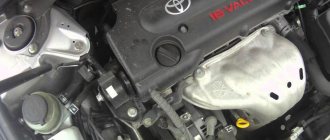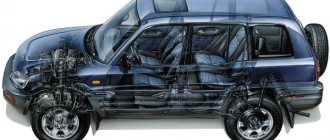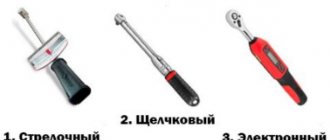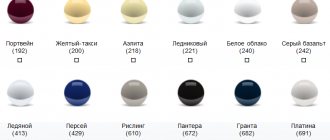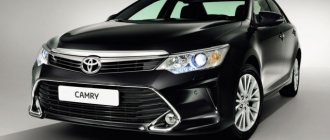Changes for Russia in 2021
- The naturally-aspirated engine with the index 6AR-FSE (2.0L), beloved by consumers, has left the assembly line. It will be replaced by the M20A-FKS in 2021. The same 2 liters of volume, power remained at 150hp. Torque increased to 206 hm at 4400 rpm. New engine with higher compression ratio. The “eternal” automatic transmission in the minimum configuration will be replaced by a CVT.
- The 2.5 liter engine has been modified. Combined injection, compression ratio increased to 13.1. Max. torque increased to 243 Hm at 4000 rpm. Despite the increased compression ratio of both engines, fuel requirements have not changed. AI92 is officially supported. For the 2.5L engine, the 6speed automatic transmission was replaced with an 8speed one.
- The configurations with the 3.5L engine remained unchanged.
Engine V 6, Check VSC System error
A fairly common mistake on 3.5 liter engines. Basically, as the owners of the XV 40 say, there is no need to worry; there are often cases when the error disappears on its own after a certain time; the VSC sensor can make itself felt due to technical shortcomings of the system.
If after a while the error does not go away, but the car drives normally, check the sensor itself. It may need to be replaced.
If the engine is unstable and the indicator lights up, the ignition coil will have to be replaced.
They also write on the forums that they managed to “solve” the error problem by replacing the battery.
How to quickly find out the country of origin
Toyota Camry 2021
There are enough ways to accurately determine the country of assembly of the Toyota Camry. Let's look at quick check options.
The most common way is to determine the manufacturer by the vehicle's VIN number. Russian-assembled models have the letter X at the beginning of the VIN number, and in the case of Japanese manufacture, the letter J is written. You can obtain detailed information about a specific car through specialized online services. After entering the car's VIN number, the user will be given information about the country of manufacture, date of manufacture, body color and main technical characteristics.
To quickly determine the country of assembly of the Toyota Camry, during a visual inspection you need to pay attention to the following nuances:
- On Japanese-built cars, there is an eyelet installed under the rear bumper for connecting a safety cable. This element is provided in connection with the transportation of the machine from Japan by sea. Russian models do not have such an eye;
- Russian models are equipped with domestically made glass. Therefore, by looking at the glass markings, it is easy to determine the country of the manufacturer. In this case, it is necessary to take into account the likelihood of glass replacement due to an accident or cracking.
Video
In which countries is Camry produced?
Toyota camry v50
Japanese developers of Toyota Camry have achieved an excellent combination of design and technical characteristics, which is confirmed by the increased demand for the car. Camry is manufactured at six factories located in five countries. Production workshops are equipped with high-quality equipment.
The main manufacturer of the Toyota Camry model is Japan. At the same time, the best quality of car assembly is noted in comparison with other enterprises. Production workshops are located in the province of Aichi.
There are two factories in the USA where Camry is assembled. The main production facilities are located in Kentucky. The second plant is located in Indiana. There, Toyota Camry assembly has been carried out in partnership with other corporations since 2003.
In 2009, Toyota Camry production was established in Australia, in the city of Alton. Cars produced from the assembly line, including those with hybrid engines, are supplied to markets in the Pacific Ocean regions.
Another plant is located in Guangzhou in China. This company, operating since 2006, also produces hybrid power units for Camry.
Suspension
The suspension, like the entire car as a whole, is indestructible. The main problem parts are the front and rear stabilizer bushings, which give themselves away with a characteristic creaking sound when driving over uneven surfaces.
Sound insulation
of the Camry XV40
Another miscalculation that some owners talk about with reproach is the car’s poor sound insulation. The engine compartment, doors and arches transmit too many extraneous sounds.
| Average cost and average mileage of Toyota Camry XV 40 | ||
| Year | Average cost | Mileage (according to the indicated owners) |
| 2006 | 550.000 | 150.000 |
| 2007 | 600.000 | 130.000 |
| 2008 | 650.000 | 100.000 |
| 2009 | 700.000 | 95.000 |
| 2010 | 750.000 | 85.000 |
| 2011 | 800.000 | 79.000 |
Result:
If you are looking for a reliable car in the mid-price category, the previous generation Camry is your choice. Both the pre-restyling version and the model produced from 2009 to 2011 are excellent for use in style, minimum costs, maximum driving pleasure.
The most acceptable option is with a 2.4 liter engine and automatic transmission. This model combines the same legendary reliability and high level of comfort.
The first generation of the Toyota Camry was introduced in Japan in 1982, and exports to the USA and Europe soon began. The front-wheel drive model was produced in sedan and hatchback bodies and was equipped with 1.8 and 2.0 petrol engines, as well as a two-liter turbodiesel. In the Japanese market the car was also sold as .
Build quality in Russia
Toyota Camry model range
Experts note that the quality of the Russian assembly of the Toyota Camry model is inferior to the identical Japanese assembly model. This is reflected in the following differences:
- Japanese assemblers equip the car with Yocohama tires, and Russian assemblers use Michlen;
- when performing paint and varnish work at a plant in Russia, materials of lower quality are used;
- When installing glass elements, Russian-made products are used. It is also inferior in quality to Japanese glass.
Camry and Rav 4 are produced in Russia
Passenger seats are manufactured directly in the production shops of the Russian enterprise. Their quality fully corresponds to the level of chairs from Japanese manufacturers, while the design is completely identical.
In general, the build quality of the Russian company is comparable to Japanese models. This is due to strict adherence to the technological process. All individual production operations are carried out in accordance with the instructions. They are the same for all factories. Cars are subject to specialized quality control, which allows them to maintain the required reliability and quality. If significant defects are detected, the machine is sent for recycling. Camry characteristics such as dynamics, handling, interior equipment and noise insulation are at the same level as cars assembled in Japan.
Toyota camry all wheel drive
In the Other Auto Topics , to the question What kind of drive does the Toyota Camry have? asked by the author Albina, the best answer is that the Europeans have a front-wheel drive, but the Japanese also have full 4WD!
Reply from 22 replies
Hello! Here is a selection of topics with answers to your question: What drive does the Toyota Camry have?
Reply from Marriage Bad
Answer from Neurosis Front
Answer from Vskorost front pivod exactly
Reply from Bear Front
Answer from Enat Minibaev Of course, this is the same Camry
Answer from Joan of Arc Either front or full
- New Toyotas 2021: crossovers, sedans, SUVs, cars, photos and prices
Reply from Soulja_ Boy front
Answer from Molly Nice All Camrys have front-wheel drive
Reply from ALex_bmw front
Stages of creating and modernizing a car
Stage 1
The first acquaintance with the Toyota Camry occurred in the Japanese car market in the early 1980s, but the car was sold under the name Toyota Vista. After a short time, it was already exported to European countries and the United States of America. This car had sedan and hatchback bodies, was equipped with a 2 liter turbodiesel, as well as 1.8 and 2 liter petrol units.
Stage 2
The next stage of development came in 1986, when factories in Australia and the United States of America produced the brand with sedan and universal bodies. The newest configuration contained engines of 1.8–2 liters, a six-cylinder V version of 2.5 liters and power from 82 to 160 horsepower.
Stage 3
The next modification of the Toyota Camry was created by Japanese car factories in the middle of 1990, had a V30 value and was intended exclusively for sales within the country.
In Japan itself, the brand was sold as the Toyota Specter sedan and hardtop. Buyers were offered a car in an all-wheel drive version, equipped with 4-cylinder units of 1.8, 2, 2.2, and a V-shaped engine of 2.3 liters with 6 cylinders.
The 1991 model, demonstrated in America, was produced in sedan, station wagon and coupe versions, equipped with a 2.2-liter engine with a power of 130 hp. With. The most expensive types had V6, 3 liter and 185–190 liter units. With.
Stage 4
In the next branch of modernization, Toyota Camry was divided into a model for Japan and an export version.
For sale in Japan, Camry with the value V40 began production in 1994. The car had a sedan body and retained the hybrid platform with Vista. This brand of car was equipped with a 1.8 and 2 petrol engine and a 2.2 liter turbodiesel. All-wheel drive transmission appeared with 2 and 2.2 liter engines.
Camry with the index XV20 has been presented for export since 1996, including the Russian car market, but in Japan it bore the name Daihatsu Altis and Toyota Camry Grace and did not undergo any technical changes.
Since 1991, the Toyota Camry Solara coupe and convertible have been sold to American car enthusiasts.
Stage 5
Toyota Camry, produced for 6 years, starting in 2001, had a sedan body and became popular in Russia. In our market, the car had the following engines:
- 4, power 152 hp. With. and a four-speed automatic transmission (as an option);
- V6 3.0 and 186 hp. With. (standard).
In the car markets of other countries, a model with 3.3 liters was offered. In Japan itself, the Toyota Camry all-wheel drive had a 2.4 liter engine and an automatic transmission.
Stage 6
At the beginning of 2006, a new generation of Toyota Camry models was presented, and immediately in 2007, the assembly of Camry sedans began at the domestic plant, which is located in the Leningrad region.
In the car markets of other countries, other versions of the Camry car were offered:
- 5 l, power 181 l. With. and all-wheel drive;
- 4 l, power 188 l. With. and mechanical parts from a Prius.
A different model was delivered for sale in China and Asia under the Camry brand - a larger Aurion sedan, assembled on the previous platform.
Stage 7
The last step in modernizing the car took place in 2011, its result is an updated Toyota Camry sedan, equipped with one of three engine options (2.0, 2.5, 3.5) and a six-speed automatic transmission. Cars for our car market are assembled at the St. Petersburg plant.
Second generation Toyota Camry - V20 1986 - 1990
The second generation Toyota Camry was produced from 1986 to 1990. Compared to the first generation, the rounded shape of the car was clearly visible. Thus, the developers have increased aerodynamic performance.
Camry V20 - second generation
Gasoline engines for the V20 were used exclusively of the injection type:
- 1.8 1S-i 85 horsepower;
- 1.8 4S-FI 105 hp;
- 2.0 3S-FE 120 horses;
- 2.0 3S-GE 140 hp
There was only one diesel engine for the V20 - 2.0 2C-T 82 hp. (85 horses after the model was restyled in 1988).
All engines were equipped with a manual gearbox or automatic transmission in 5 and 4 stages, respectively.
Salon V20. Pay attention to the digital instrument panel.
After restyling in 1988, the top-spec GT (GranTurismo) version appeared. It featured the most powerful engine, a strut under the hood, an improved air conditioning system, a rigid TEMPS sports suspension, and more.
The second generation vehicles were distinguished by increased engine life, high corrosion resistance and improved safety indicators.
- New Toyota Camry 2021: photo and price, sedan characteristics
Review of the new XV70 model
Exterior
The rear lights of the new Toyota Camry 2021 make a strange impression. There seems to be a crack in the middle, running through the entire light and continuing on the bumper - or is this a bold idea of the designers? No, fortunately, the car is intact, and these “cracks” are pseudo-deflectors, an attribute of the sports versions of the new product.
Another striking sign of sports modifications is the four exhaust pipes.
The wheelbase has been increased compared to the previous Camry. The new car is built on the TNGA platform, which first appeared five years ago on the hybrid Prius.
In general, the sports and “regular” versions of the new product are noticeably different in appearance. Basic modifications of the 2021 Toyota Camry can be recognized by the wide false radiator grille, and these are the versions that will be supplied to our country.
Interior
In the sports version, the instrument scales are illuminated in red, in other versions they are illuminated in a calmer white, cool yellowish tint.
The display is now placed above the central vents, whereas previously it was below them. Its size increased from eight inches to nine. A larger size for this model is not provided for by European standards, but American models also have larger display options. Manufacturers also took care of improving the Safety Sense complex: now the smart automatic braking system is able to recognize pedestrians and cyclists both on turns and in front of the car.
The interior material is plastic. Decorative inserts can be made of the same plastic, but metallized, as well as leather and wood.
The volume of the luggage compartment has been noticeably reduced compared to the old version: 469 – 493 liters versus the previous 506.
Technical equipment
The American versions already on sale in the United States and the Russian Toyota Camry 2021 have differences in the technical “stuffing”. For example, US cars have an eight-speed automatic transmission, which will not be available in Russia. Instead, there will be versions with a six-speed, also automatic, and the old power plant. As for the US versions, their engine has been updated.
The restyled version of the Camry was demonstrated at American sites last summer, but for Europe the car will be produced with some features. For example, the appearance of the radiator grille in the bumper will change; it will now have a more aggressive design. In addition, the appearance of the wheels will change. The fog lights are retained from the previous version of Toyota, which the American models do not have. The rear of the body remains unchanged, but the interior has undergone significant modernization.
In Europe, only the Toyota Camry Hybrid is sold with a 2.5 naturally aspirated engine, an electric motor and an electromechanical variator with 218 horsepower, but Toyota has refused purely gasoline engines.
The more powerful 3.5-liter engine has been modernized. Power has increased to 301 horsepower, despite this, the American press does not see any sporting potential in it.
Features of purchasing an American Toyota Camry
When buying a car in the USA, you should take into account that cars that meet Euro 5 standards and higher can be imported into the Russian Federation. After purchasing a vehicle, you must arrange delivery and pay customs duties. Additional costs amount to 60% or more of the starting cost of the car, so most cars are purchased with damaged bodies; repairs are carried out after the vehicle is delivered to Russia.
Where to make a purchase and what you will need
The purchase of a car is carried out through an auction, in which only dealers or licensed companies can participate. A potential buyer needs to enter into an agreement with a company that will purchase the selected car and send the goods to Russia. Before the start of bidding, an advance payment is transferred to the account of the intermediary organization (the amount depends on the terms of the contract). The distance from the auction site to the shipping port should be taken into account, since the delivery of the car is at the expense of the new owner.
After completing a transaction at an auction, you must pay the trading platform commission. The intermediary organization then delivers the car to the port, takes a series of photographs and packs the car into a container. The buyer receives a container number by which the delivery route is tracked. After the car arrives on the territory of Russia, customs clearance is carried out, after which a PTS is issued for the car.
What to do with customs
When importing a car from abroad, you will need to pay the following fees:
- for customs clearance;
- customs duty (depending on the age of the car and the value declared in the declaration);
- recycling tax.
Possible problems
After purchasing a car at an auction, it is necessary to arrange delivery to Russia. For transportation, the sea route is used; the vehicle is installed in a container or on deck. Under the influence of sea salt, the paintwork and chrome elements may be damaged; in addition, delivery by water takes from 1 to 3 months.
An additional problem will be reloading the car from one container to another. Since in this case damage to the body is possible, it is recommended to take out insurance. The document increases the cost of the car, but restoring the body will cost more. It is recommended to pre-order a dry cleaning procedure for the interior with replacement of damaged elements (the condition of the parts is determined from the photo). Otherwise, a car delivered to Russia will surprise the owner with dirty seats and scratched door cards.
In the USA, before selling cars at auctions, the odometer is not twisted (such manipulations are punishable), but after delivery it is necessary to carry out maintenance with replacement of fluids. During the diagnostic process, damaged elements in the chassis (for example, levers or hinges) may be discovered that will need to be replaced. It is not recommended to purchase cars that were leased, since the owners maintain cars with violations of regulations.
The first plant of Toyota Motor Manufacturing Russia
The start of construction of the first Toyota Camry assembly plant in Russia dates back to June 14, 2005. A territory was allocated for the factory workshops of the Toyota concern in the Leningrad region, in the industrial sector of the village of Shushara. The machine production line was launched for the first time on December 21, 2007. On the same day, the opening ceremony of the Toyota Motor Manufacturing Russia enterprise took place. It was attended by officials from Japan and Russia.
The company operates in a two-shift mode. To improve the qualifications of working personnel, business trips to foreign enterprises are organized. The sales market for manufactured products, in addition to Russia, covers Kazakhstan and Belarus. Starting in April 2018, production of the new generation Toyota Camry began in Russia.




